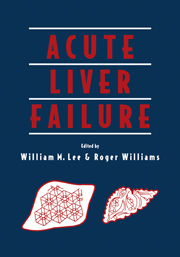Book contents
- Frontmatter
- Contents
- Preface
- Foreword
- Acknowledgments
- Contributors
- Part One Clinical Syndrome and Etiology
- Part Two Mechanisms of Disease and Multisystem Involvement
- Part Three Intensive Care Management
- Part Four Transplantation
- 14 Prognosis and consideration of transplantation
- 15 Liver transplantation in patients with acute liver failure: the European experience
- 16 Transplantation for acute liver failure: the American experience
- 17 Auxiliary liver transplantation
- Part Five Artificial and Bioartificial Liver Devices
- Part Six Other Applications
- Index
- Plate section
17 - Auxiliary liver transplantation
from Part Four - Transplantation
Published online by Cambridge University Press: 20 May 2010
- Frontmatter
- Contents
- Preface
- Foreword
- Acknowledgments
- Contributors
- Part One Clinical Syndrome and Etiology
- Part Two Mechanisms of Disease and Multisystem Involvement
- Part Three Intensive Care Management
- Part Four Transplantation
- 14 Prognosis and consideration of transplantation
- 15 Liver transplantation in patients with acute liver failure: the European experience
- 16 Transplantation for acute liver failure: the American experience
- 17 Auxiliary liver transplantation
- Part Five Artificial and Bioartificial Liver Devices
- Part Six Other Applications
- Index
- Plate section
Summary
INTRODUCTION
Although conventional orthotopic liver transplantation (OLT), that is, resection of the native entire liver and its replacement by an allograft, is the most effective means of rapidly restoring liver function in patients with acute liver failure (ALF), this procedure still has many drawbacks. In particular, it carries the risks inherent in long-term immunosuppression, such as Ebstein–Barr virus-related lymphoproliferative syndrome and lymphoma, increased incidence and severity of acute infections by common pathogens, and frequent cyclosporin- or FK506-related chronic renal impairment. It also rules out native liver regeneration, yet livers removed from patients with ALF always show clusters of viable hepatocytes that could be the starting point for regeneration. Moreover, because the availability of liver allografts is unpredictable, the fear of losing a patient while waiting for a graft may sometimes lead to unnecessary early transplantation. Finally, in some cases, the severity of neurological status leads to acceptance for transplantation of an ABO-incompatible liver, with an increased risk of mid-term sclerosing cholangitis and subsequent destruction of the graft.
Auxiliary liver transplantation (ALT) has been developed in an attempt to overcome these problems. It consists of implanting an additional liver in the abdominal cavity as a temporary means of restoring liver function. When the native liver has regenerated, then the auxiliary graft can be removed and immunosuppressive therapy stopped.
- Type
- Chapter
- Information
- Acute Liver Failure , pp. 211 - 222Publisher: Cambridge University PressPrint publication year: 1996



